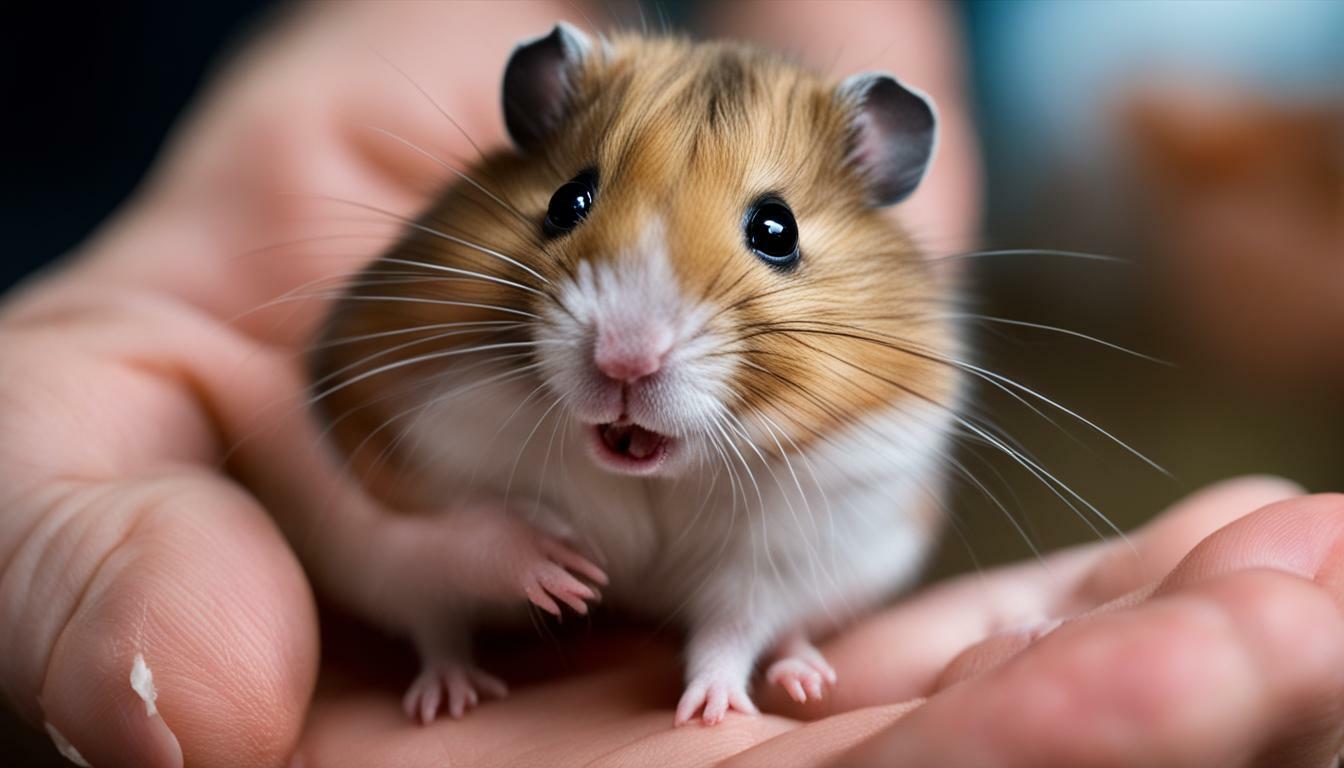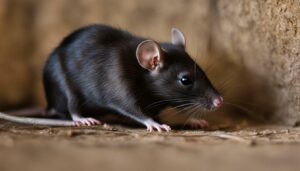Hamster bites can cause injuries and carry some risk, but they are generally not considered dangerous. While they can result in small puncture wounds and potential infections, serious complications are rare. It is important to clean the bite and monitor for signs of infection. In some cases, specific antimicrobial therapy may be necessary. There have been rare cases of hamsters transmitting diseases such as rabies, lymphocytic choriomeningitis, and tularemia, but these instances are uncommon. Overall, hamster bites are generally not considered high-risk for disease transmission to humans. It is important to handle hamsters properly and provide them with appropriate care to reduce the risk of biting.
Key Takeaways:
- Hamster bites can cause small puncture wounds, but serious complications are rare.
- It is important to clean the bite and monitor for signs of infection.
- Specific antimicrobial therapy may be necessary in some cases.
- Instances of hamsters transmitting diseases to humans are uncommon.
- Proper handling and care can help reduce the risk of hamster bites.
Understanding Hamster Bite Injuries
When a hamster bites, it can result in small puncture wounds that require proper treatment. These bites are often painful and can sometimes lead to infection if not cared for correctly. While hamster bites are generally not dangerous, it is important to understand how to handle them to prevent complications.
To treat a hamster bite wound, start by washing the area thoroughly with soap and warm water. Gently remove any debris or dirt from the wound. Apply an antiseptic ointment to help prevent infection and cover the wound with a clean bandage. It is essential to keep the wound clean and dry to promote healing.
In addition to immediate first aid, it is important to monitor the bite for any signs of infection. Watch out for excessive redness, swelling, or discharge. If you notice any of these symptoms, it may indicate an infection, and it is advisable to seek medical attention. In some cases, antimicrobial therapy may be necessary to treat the infection effectively.
In conclusion, while hamster bites can cause small puncture wounds and potential infections, they are generally not considered dangerous. By providing timely and appropriate first aid, cleaning the wound properly, and monitoring for signs of infection, you can minimize the risk of complications. Remember to handle your hamster with care and provide them with the necessary care to reduce the likelihood of biting incidents.
Potential Complications and Infections
While serious complications from hamster bites are rare, it is important to be aware of potential infections and take appropriate care. Hamster bites can cause small puncture wounds that have the potential to become infected if not properly cleaned and treated.
When caring for a hamster bite, the first step is to thoroughly clean the affected area with mild soap and warm water. Gently pat the wound dry with a clean towel and apply an over-the-counter antibiotic ointment to help prevent infection. Be sure to cover the bite with a clean bandage to protect it from further contamination.
Regularly monitor the bite for signs of infection, such as increased redness, swelling, warmth, or pus. If any of these symptoms develop or worsen, it is important to seek medical attention. A healthcare professional may prescribe specific antimicrobial therapy to treat the infection and prevent further complications.
| Signs of Infection | Seek Medical Attention If… |
|---|---|
| Increased redness | The bite becomes increasingly painful |
| Swelling | The wound does not show signs of improvement after proper care |
| Warmth | There is excessive or persistent bleeding |
| Pus | Symptoms of infection spread beyond the bite area |
While rare, it is important to note that hamsters have the potential to transmit certain diseases through bites. These include rabies, lymphocytic choriomeningitis, and tularemia. However, it is uncommon for hamsters to carry these diseases, and the risk of transmission to humans is generally low.
To minimize the risk of hamster bites and potential infections, it is crucial to handle hamsters properly. Always approach them calmly and avoid sudden movements that may startle or provoke them. Offer treats or toys to redirect their attention and discourage biting. Providing hamsters with a comfortable and enriching environment can also help reduce stress and aggressive behaviors.
Rare Instances of Disease Transmission
Although uncommon, there have been documented cases of hamsters transmitting diseases to humans through bites. While the risk of disease transmission is low, it is essential to be aware of potential health concerns. Some of the diseases that can be transmitted by hamsters include:
- Rabies: This viral disease affects the central nervous system and can be transmitted through the saliva of infected animals. However, cases of rabies transmission from hamsters are extremely rare.
- Lymphocytic Choriomeningitis (LCM): LCM is a rodent-borne viral infection that can be transmitted through direct contact with the urine, saliva, or droppings of infected hamsters. While most cases are mild, severe infections can occur, especially in individuals with weakened immune systems.
- Tularemia: Also known as rabbit fever, tularemia is a bacterial infection that can be transmitted through the bites of infected animals, including hamsters. It can cause various symptoms, including fever, swollen lymph nodes, and skin ulcers.
It is important to note that these instances are uncommon, and the majority of hamsters do not carry these diseases. However, it is still crucial to take precautions when handling hamsters to minimize the risk of disease transmission. Proper hygiene, such as washing hands thoroughly after interacting with hamsters, can significantly reduce the chances of infection.
Reducing the Risk of Disease Transmission
To further reduce the risk of disease transmission from hamster bites, it is recommended to:
- Handle hamsters gently and avoid provoking them.
- Use appropriate protective gear, such as gloves, when handling hamsters that may have a higher risk of carrying diseases.
- Keep hamsters in clean and hygienic environments, regularly cleaning their cages and bedding.
- Seek veterinary care for hamsters that show signs of illness or unusual behavior.
- Ensure that children are supervised when interacting with hamsters to prevent bites and potential disease transmission.
By following these guidelines, you can enjoy the companionship of your hamster while minimizing the risk of disease transmission. Remember, the overall risk is low, and with proper care and handling, hamsters can make wonderful pets.
| Disease | Transmission | Symptoms |
|---|---|---|
| Rabies | Saliva of infected animals | Fever, headache, muscle aches, confusion, difficulty swallowing |
| Lymphocytic Choriomeningitis (LCM) | Direct contact with hamster urine, saliva, or droppings | Fever, headache, muscle aches, vomiting, meningitis |
| Tularemia | Bites of infected animals | Fever, swollen lymph nodes, skin ulcers |
Overall Risk Assessment
When evaluating the dangers of hamster bites, it is important to understand the overall risk and context. While hamster bites can be painful and cause small puncture wounds, they are generally not considered dangerous. Serious complications from hamster bites are rare, but it is still important to take proper care.
Hamster bites can potentially lead to infections if not properly cleaned and monitored. It is crucial to clean the bite thoroughly with soap and water, and apply an antiseptic ointment to prevent infection. Regularly observe the bite for any signs of redness, swelling, or pus, which could indicate an infection. If any concerning symptoms develop, seeking medical assistance is recommended.
In some cases, antimicrobial therapy may be necessary to treat an infected hamster bite. Depending on the severity of the infection, a healthcare professional may prescribe antibiotics or other medications to help prevent the spread of bacteria. It is important to follow their instructions carefully and complete the full course of treatment.
While rare, there have been instances of hamsters transmitting diseases to humans through bites. Diseases such as rabies, lymphocytic choriomeningitis, and tularemia can be transmitted in these cases. However, it is important to note that these instances are uncommon and not a common concern for most hamster owners. By handling hamsters properly and providing them with appropriate care, the risk of biting can be minimized.
| Key Points: |
|---|
| Hamster bites are generally not dangerous, but can cause small puncture wounds. |
| Serious complications from hamster bites are rare, but it is important to clean the bite thoroughly and monitor for signs of infection. |
| Antimicrobial therapy may be necessary for infected bites, and it is important to seek medical assistance if needed. |
| Instances of disease transmission from hamster bites are uncommon, but proper handling and care can reduce the risk. |
Proper Handling and Care
To reduce the risk of hamster bites, it is crucial to handle hamsters in a proper and safe manner. These small creatures may bite when they feel threatened or frightened, so it’s important to approach them gently and calmly. Here are some tips to help you handle hamsters without getting bitten:
- Approach the hamster slowly and speak to them in a soothing voice to help them feel more at ease.
- Always wash your hands before handling your hamster to remove any strong scents that might startle them.
- Avoid sudden movements and loud noises that could startle your hamster and cause them to bite.
- Support your hamster’s body with both hands when picking them up, keeping a firm yet gentle grip.
- Avoid restraining or squeezing your hamster too tightly, as this can cause them to panic and bite.
Remember, hamsters have sharp teeth and can cause small puncture wounds when they bite. However, it’s important to stay calm if you do get bitten. Avoid pulling your hand away abruptly, as this can cause more damage. Instead, gently and slowly remove your hand from their mouth.
Creating a Safe Environment
Aside from proper handling, providing a safe and stimulating environment for your hamster can also help prevent them from biting out of boredom or frustration. Consider the following:
- Ensure your hamster has a spacious and well-ventilated cage with plenty of hiding spots and chew toys.
- Regularly clean the cage to minimize odors and maintain a clean living space for your hamster.
- Provide a balanced diet and ample fresh water for your hamster’s overall health and well-being.
- Interact with your hamster regularly to establish a bond and reduce any feelings of fear or aggression.
By following these guidelines and providing a safe and comfortable environment for your hamster, you can minimize the risk of bites and ensure a happy and healthy pet.
| Hamster Biting Prevention Tips | |
|---|---|
| Approach hamsters slowly and calmly | |
| Wash hands before handling to remove strong scents | |
| Avoid sudden movements and loud noises | |
| Support hamster’s body with both hands when picking up | |
| Avoid restraining or squeezing hamster too tightly | |
| Provide a spacious and stimulating cage | |
| Clean the cage regularly | |
| Offer a balanced diet and fresh water | |
| Interact with your hamster regularly |
Cleaning and Monitoring Bites
After sustaining a hamster bite, it is crucial to clean the wound thoroughly and monitor it for any signs of infection. Hamster bites can cause small puncture wounds, which can introduce bacteria into the skin. To prevent infection, gently wash the wound with mild soap and warm water. Use a clean cloth to carefully remove any debris or dirt from the area. Pat the wound dry with a clean towel.
Once the wound is clean, apply an over-the-counter antibacterial ointment to help prevent infection. Cover the wound with a sterile bandage or dressing to protect it from further contamination. Monitor the bite site regularly for any signs of infection, such as increased pain, redness, swelling, or discharge. If you notice any of these symptoms or if the wound shows no signs of improvement within a couple of days, it is important to seek medical attention.
In rare cases, hamster bites can lead to more serious complications, such as cellulitis or abscess formation. If you experience worsening pain, fever, or the appearance of a pus-filled pocket near the bite site, it is important to consult a healthcare professional. They may prescribe antimicrobial therapy, such as antibiotics, to treat the infection.
| Signs of Infection to Monitor: |
|---|
| Increased pain around the bite site |
| Redness, swelling, or warmth |
| Drainage of pus or fluid |
| Development of a fever |
“Cleaning and monitoring the wound is essential to prevent infections and ensure proper healing. If you’re unsure about the severity of the bite or notice any concerning symptoms, it’s always better to consult a healthcare professional for guidance.”
It is important to note that hamsters can carry certain diseases, but the risk of transmission through bites is generally low. Diseases like rabies, lymphocytic choriomeningitis, and tularemia have been associated with hamsters, but these instances are uncommon. Nevertheless, always exercise caution and proper handling techniques to reduce the risk of being bitten in the first place. Handling your hamster gently, providing them with a comfortable and stress-free environment, and respecting their natural behaviors can go a long way towards preventing bites.
Antimicrobial Therapy for Infections
In some cases, infected hamster bites may require antimicrobial therapy to prevent further complications. It is important to seek medical assistance if you notice signs of infection such as increased redness, swelling, or discharge from the bite site. The healthcare professional will assess the severity of the infection and prescribe appropriate antibiotics to target the specific bacteria causing the infection.
Antibiotics are medications that fight bacterial infections. They work by either killing the bacteria or preventing their growth and multiplication. Your healthcare provider will determine the most suitable antibiotic based on factors such as the location and severity of the infection, as well as your medical history.
It is crucial to follow the prescribed antimicrobial therapy as directed, completing the full course of antibiotics even if the symptoms improve. Failure to do so may lead to antibiotic resistance, making future infections more difficult to treat. Additionally, it is important to practice proper wound care during the course of treatment to ensure optimal healing.
| Benefits of Antimicrobial Therapy for Infected Hamster Bites |
|---|
| Eliminates or reduces the infection |
| Prevents the spread of infection to surrounding tissues |
| Decreases the risk of complications such as abscess formation |
| Promotes faster healing |
Remember, prevention is always better than cure. To minimize the risk of hamster bites and potential infections, ensure you handle your hamster gently and appropriately. Avoid sudden movements and provide a stress-free environment for your pet. Regularly clean and sanitize their living space, as it can help reduce the chances of bacterial growth. By implementing these preventive measures and promptly seeking medical attention when necessary, you can ensure the safety and well-being of both you and your furry friend.
Handling Rare Disease Transmission Risks
While rare, it is important to be aware of the risks associated with hamster bite diseases and take necessary precautions. Hamsters, like other animals, have the potential to transmit diseases to humans through bites. However, it is important to note that these instances are uncommon and should not cause undue alarm.
To prevent the transmission of diseases from hamster bites, it is crucial to handle these small creatures with care. Always wash your hands thoroughly before and after handling a hamster, as this can help minimize the risk of infection. Additionally, avoid placing your hands near the hamster’s mouth or any open wounds, as this is where bacteria can reside.
“Always wash your hands thoroughly before and after handling a hamster, as this can help minimize the risk of infection.”
Furthermore, it is essential to keep your hamster’s living environment clean and hygienic. Regularly clean their enclosure, ensuring proper sanitation and preventing the buildup of bacteria. By maintaining a clean environment, you can reduce the risk of both bites and potential infections.
Observation and Immediate Action
Another crucial aspect of preventing hamster bite diseases is vigilant observation and immediate action. It is necessary to monitor the bite site for any signs of infection, such as redness, swelling, or discharge. If you notice any of these symptoms, it is important to seek medical attention promptly.
In some cases, specific antimicrobial therapy may be necessary to treat an infected hamster bite. Your healthcare provider can evaluate the wound and determine the most appropriate course of treatment. Follow their guidance closely to ensure proper healing and minimize the risk of complications.
In summary, while the risk of hamster bite diseases is rare, it is still important to understand and take precautions. By handling hamsters with care, maintaining a clean living environment, and monitoring bite wounds for signs of infection, you can greatly reduce the likelihood of experiencing any complications. Remember, providing your hamster with proper care and attention plays a vital role in preventing biting incidents and promoting their overall well-being.
| Tips for Preventing Hamster Bite Diseases: |
|---|
| 1. Wash your hands thoroughly before and after handling a hamster. |
| 2. Avoid placing your hands near the hamster’s mouth or any open wounds. |
| 3. Keep your hamster’s living environment clean and hygienic. |
| 4. Monitor bite wounds for signs of infection and seek medical attention if necessary. |
| 5. Follow healthcare provider’s guidance for antimicrobial therapy, if needed. |
Conclusion
Hamster bites, while potentially painful and carrying a small risk of infection, are generally not considered dangerous when proper care is taken. These bites can cause small puncture wounds, so it’s important to clean the affected area thoroughly with mild soap and warm water. Monitor the bite closely for any signs of infection, such as redness, swelling, or discharge. If you notice any concerning symptoms, seek medical attention.
In some cases, specific antimicrobial therapy may be necessary to treat an infected bite. If the wound becomes infected, your healthcare provider may prescribe antibiotics or recommend over-the-counter ointments to help prevent further complications. It’s crucial to follow their advice and complete the full course of treatment.
While there have been rare instances of hamsters transmitting diseases such as rabies, lymphocytic choriomeningitis, and tularemia, these occurrences are uncommon. It’s essential to maintain good hygiene practices when handling your hamster and to avoid any direct contact with their saliva or urine. Additionally, regular veterinary check-ups for your hamster can help identify and prevent any potential health issues.
To minimize the risk of hamster bites, always handle your pet gently and avoid sudden movements or loud noises that may startle them. Provide them with an appropriate and enriched environment, including a suitable cage and plenty of toys and activities. By giving your hamster proper care, love, and attention, you can foster a trusting bond and reduce the likelihood of biting incidents.
FAQ
Are hamster bites dangerous?
Hamster bites can be painful, but they are not typically dangerous. While they can cause small puncture wounds and potential infections, serious complications are rare.
How should I handle a hamster bite?
If you are bitten by a hamster, clean the bite thoroughly with soap and water. Apply an antiseptic and monitor for signs of infection, such as redness, swelling, or discharge.
Can hamster bites transmit diseases?
There have been rare cases of hamsters transmitting diseases such as rabies, lymphocytic choriomeningitis, and tularemia, but these instances are uncommon.
How risky are hamster bites for disease transmission?
Overall, hamster bites are generally not considered high-risk for disease transmission to humans. Proper handling and care can help reduce the risk of biting and disease transmission.
How can I prevent hamster bites?
It is important to handle hamsters properly and provide them with appropriate care to reduce the risk of biting. Avoid sudden movements, approach them gently, and never provoke or startle a hamster.
How should I clean and monitor a hamster bite?
Clean the bite with soap and water, apply an antiseptic, and keep an eye on it for signs of infection, such as increased pain, redness, or discharge. Seek medical attention if symptoms worsen or persist.
When should I seek antimicrobial therapy for a hamster bite infection?
If a hamster bite becomes infected, you may need antimicrobial therapy. Contact a healthcare professional for evaluation and appropriate treatment.
How can I prevent the transmission of diseases from hamster bites?
To minimize the risk of disease transmission from hamster bites, handle them properly, avoid contact with their saliva or urine, and practice good hygiene, such as washing hands after handling a hamster.
What is the conclusion regarding hamster bites?
Hamster bites are generally not considered dangerous, but proper handling and care are essential to prevent injuries and infections. Monitor bites for signs of infection and seek medical attention if needed.




